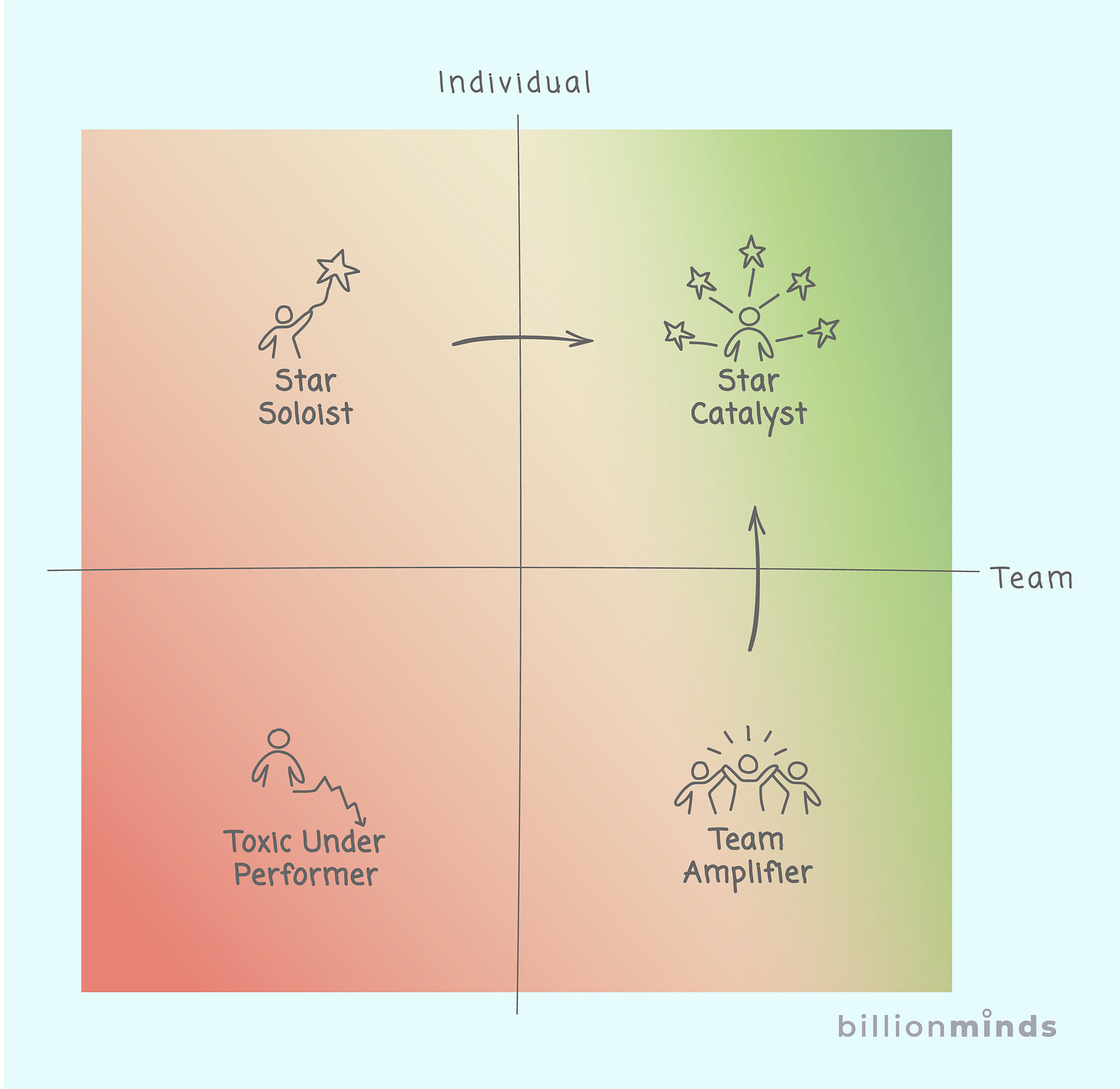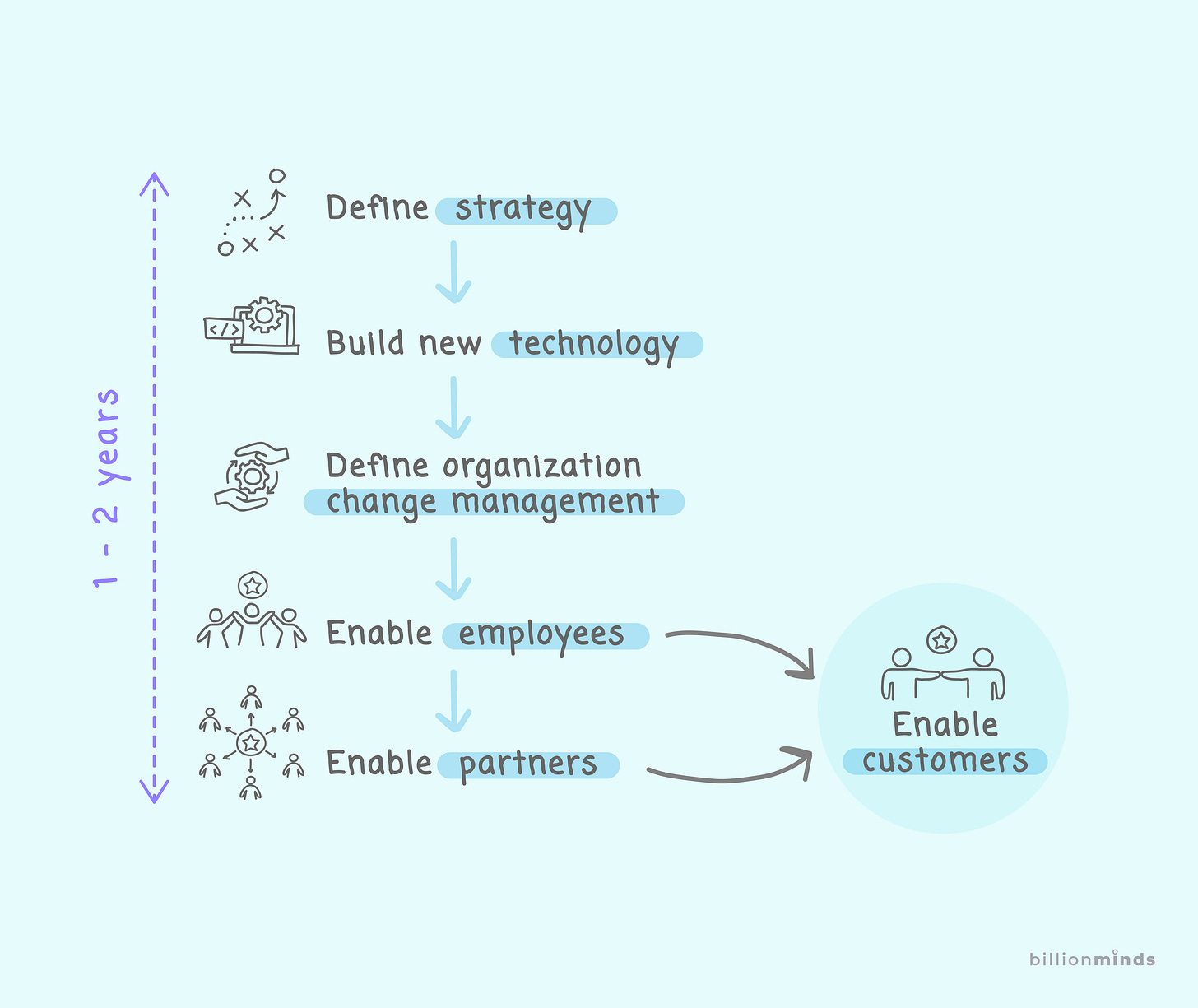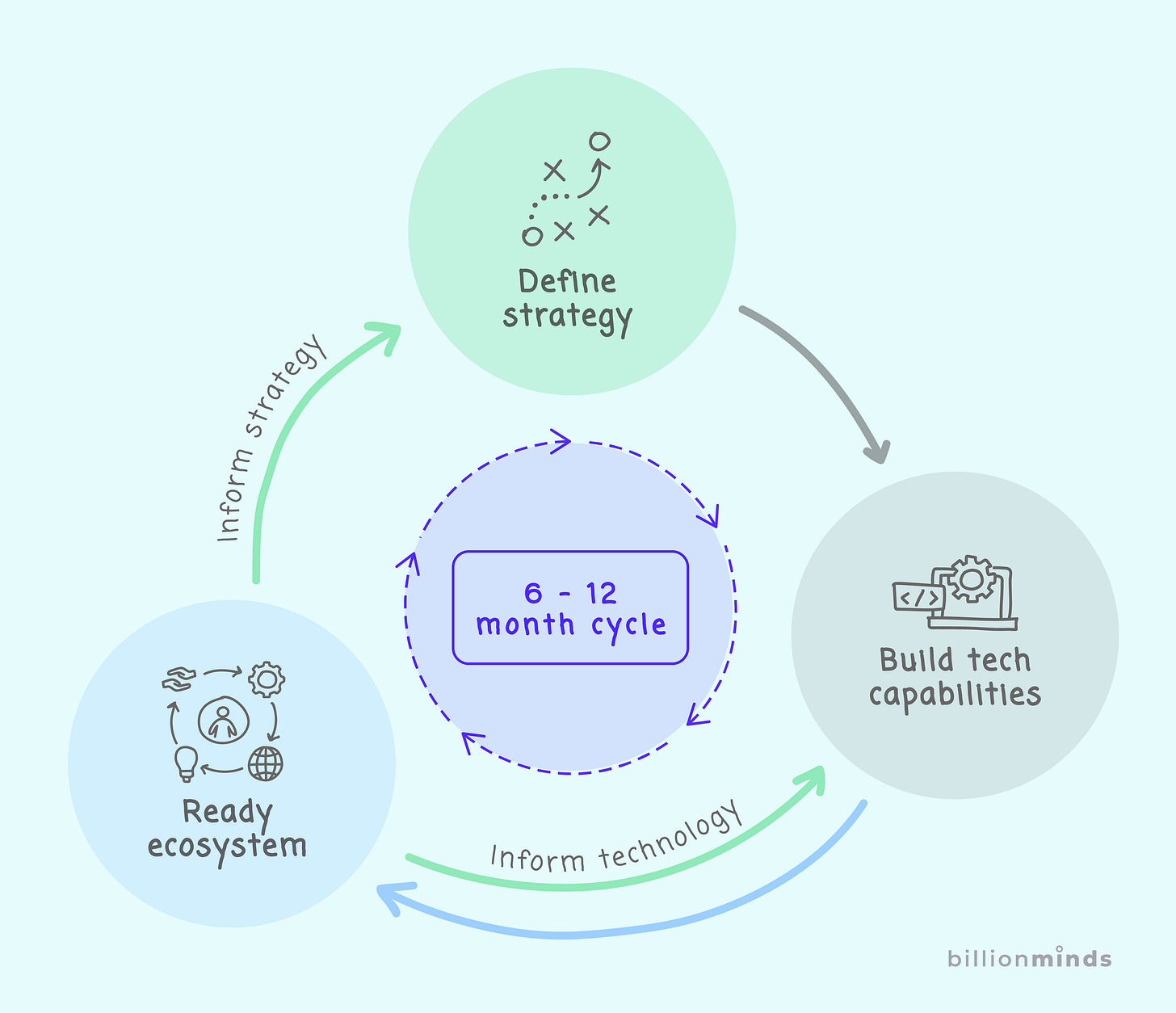Why Human Value Is Often Hidden in Organizations
And what to do about it
At the time of writing, the unemployment rate in the United States is 4.2% - a number that economists would have historically called “Full Employment”.
But it doesn’t feel that way, does it? Every week, we hear news of substantial layoffs, particularly in big tech, as we enter a post-pandemic, increasingly AI-dominated world. And it’s not clear that the journey is at an end.
Look beneath the surface, and several things are happening at once. For now (and likely only for now, given the lowering costs of robotics), low-wage service workers are in high demand, in fields like hospitality and healthcare. Meanwhile, higher-paid professionals, especially in tech, marketing, HR, and other “middle-office” roles, are being laid off in significant numbers.
We are probably in, or entering, a white-collar recession.
Over the next few weeks, I’ll explain what this means from a skills perspective—specifically, the skills we need to focus on to navigate this storm. Today, however, I want to look at the bigger picture of how human value is being perceived in organizations, how I believe it should be, and what companies can do differently in this new world of work.
Much of what I’m talking about here is inspired by a fascinating conversation I had recently with Dr. Keith Keating, the Chief Learning Officer at BDO Canada. We’ve posted it as a long-form interview on our Humanity Working podcast and you can see the episode here:
Dr. Keating’s got a great new book out which I thoroughly recommend - called Hidden Value: How to Reveal the Impact of Organizational Learning. On the surface our conversation was just about that - the value that organizational learning brings, and how Learning and Development teams can demonstrate that value. But I came away from both the book and the discussion realizing that it was actually about much more than that - how value is perceived in an organization, what kind of decisions organizations make based on that those perceptions, and what the impact is of those decisions.
That’s especially important right now, because every time a company lays people off, they are making value judgements. And if they get those value judgements wrong, they put the long term future of their organization at risk.
How Humans Provide Value within Organizations
Because humans are complicated, the way they provide value to organizations is also complicated. There are three factors that contribute most to this complexity.
The first factor is centered around the nature of job roles. Larger organizations typically have around 35-60% of their organization that directly contribute to increasing revenue or lowering costs, in roles like sales and manufacturing. Which means that around 40-65% are at least a degree of separation from it.
That’s not a bug. It’s inherent in how any organization, or even how any organism works. Think of your own body. Do your kidneys directly help you do meaningful work? No. But try living a day without them.
All those roles in an organization that are at least one degree of separation away from costs or revenue are not LESS important, but the challenge is that their value is inherently harder to see. Just like our kidneys, we only see the consequences when something goes wrong.
The second factor is how humans fulfill those roles. Because we are human, we all approach our roles in different ways, making use of our individual strengths and weaknesses. To see this, imagine a team of content developers - Alfie, Betty and Cindy. Alfie is a writing machine - creating dozens of pieces of content a day. Betty can barely produce half of what Alfie does, but she’s amazing to bounce ideas off - in fact when other team members get stuck, they go to her for a fresh perspective. And Cindy? She’s only racking up 2-3 pieces of content a day, but has an amazing historical perspective. If you want to know what’s been produced before, what worked and what didn’t, or what’s been written in the literature? Cindy is your person.
In this scenario, even though Alfie, Betty and Cindy all have the same job roles, they all bring different qualities to the team, and collectively they ensure that the content development team produces not just quantity but quality. But if you only measure the amount of content developed and you don’t just disproportionately reward Alfie, you encourage Betty and Cindy to move away from the value they bring to the team.
Third, but no less important are the intangibles that each person brings to their job - how they work as individuals and how they contribute more broadly to the team. As I discussed in They Look Great on Paper…Until They Join Your team - in the vast majority of work environments, we tend to focus disproportionately on the value employees bring as individuals and less on the value they bring to the team and organization, even though in most cases the latter is MORE important, and the combination of the two is priceless, as shown in this diagram, which we call the IVT (Individual vs Team) Matrix.
Sum all this up, and the reality is that a huge amount of the value humans provide to an organization is extremely difficult to measure directly.
But where organizations go wrong…repeatedly…is in assigning less value to the stuff that is more difficult to measure, precisely BECAUSE it is more difficult to measure. This usually leads to chronic under investment in the “nice to haves” - things like learning and development, employee wellbeing, and even Enterprise Architecture.
The result over time is usually an organization that dies slowly, or consistently fails to reach it’s potential, usually blaming external forces for doing so.
How to Detect Human Value
Most organizations need a reset in terms of how they measure value, reflecting the fact that work has changed.
In the old world of fixed job descriptions and tightly defined roles, we used direct metrics to understand how the organization was doing - metrics that were largely related to the nuts and bolts of the business. These would be things like how much money the company was making, what costs it was incurring, and how efficient its manufacturing processes were. And when it came to the humans in the organization, measures like absenteeism and punctuality, were often perfectly useful, because what humans were expected to do was so predictable.
But today, a lot of work is unstructured and ambiguous. The value that humans bring to the workplace is a combination of tangible and intangible. So, while the direct metrics related to financials, infrastructure and process still apply, the ones related to humans aren’t really fit for purpose.
The intangible benefits humans bring at work are often harder to track, yet they are frequently as or more important than the tangible stuff. So it is vital we do not fall into the trap of assigning these intangibles lower or zero value, just because we find it difficult to measure them.
To address this challenge, organizations need to get more comfortable with more indirect measures of human value but ones that are more appropriate. It can be very hard to measure if an employee is a good colleague, but it is possible to see if others choose to work with them or shy away, or even if colleagues leave the team at higher rates. As Keith and I discussed in the podcast, these types of measures often include a qualitative element, and that should be ok.
But secondly, these measures should give true insight into the value humans bring as individuals, to the team and to the organization. When we work with companies on this, we use the IVT Matrix shown above, combined with a series of assessments to provide our best approximation of the value people are providing, and to make sure that we are not over-indexing on individual behaviors at the expense of the team or organization.
Is it exact? Absolutely not, but is it better than systematically devaluing things that are difficult to measure? 100%.
How Organizations Can Improve Human Value
There are basically three ways. Hire people who provide high value to the organization, ensuring that the workplace remains highly attractive to the people who provide the most value to the organization, and growing the people who work in the organization.
All three are vital, but growing people who work in an organization is by far the most effective, when it’s done well. This is because it can affect everyone in the organization continuously, and ensure that as circumstances change, people change with it.
This is a learning and development function, but done well, it’s far more strategic than it has traditionally been in most organizations. Organizations are now changing continuously, and with that, the people in those organizations need the right combination of job specific and durable skills to thrive amidst the change. As Keith and I discussed - L&D has the ability to provide unique insight on human dynamics in an organization - where growth is happening well, what is holding it back - what’s causing resistance to change inside an organization, how culture, infrastructure and process are contributing to, or inhibiting the growth of the organization as a whole.
A truly strategic Chief Learning Officer is really a Human Growth Officer. They are responsible for ensuring that the organization is powered by adaptable and resilient employees always ready to thrive as the world of work changes. And from the perspective of the IVT Matrix, they are growing an ever increasing number of employees into Star Catalysts as shown by the arrows in the diagram.
How To Make this Exponential
So far, I’ve focused exclusively on what happens inside an organization. If you can maximize the value of humans in your organization, it is likely to be consistently successful.
But there is a way to turn this surviving into thriving, and that’s by broadening your scope, to include not just your employees but your partners and customers.
Organizations often think of themselves as an entity that is simply projecting their value to the outside world, by selling goods and services. The better they are at building things and selling those things, the more successful they will be.
But human-centric organizations are increasingly realizing there is a better model, one that actively invites customers and partners in so that they can offer their value. If your customers and partners are truly invested, they find new business opportunities for you. They actively help you grow. You aren’t selling to them any more, you are collaborating with them to benefit both parties.
This isn’t just about making information available—it’s about actively growing everyone in the ecosystem. Employees should have the broadest and deepest capabilities, understanding everything from customer pain points to internal processes. But partners and even customers should have a highly relevant and curated subset of those capabilities, so that they are ready to play their part.
A great example of this at work is when partners and customers are directly involved in and engaged in the growth of a product. Traditionally organizations worry about building products and services first, then focus on giving customers and partners what they need to adjust to those new changes.
But in a world where partners and customers are actively invited into the ecosystem, where they feel that they are part of the solution, and know enough about it to be valuable, they actively contribute to the growth of your products, because they are vested in it.
A Final Thought
As we were wrapping up the podcast, Keith mentioned to me that the three words he thinks are the most damaging in an organization are “Not my job”. He pointed out that this phrase encapsulates an entire approach to work that lacks curiosity, ownership, and growth, and contrasts completely with what’s needed to thrive in today’s workplace.
Since our discussion I’ve thought a lot about that statement, because I think it encapsulates what human value is actually all about. Our adaptability is what keeps us valuable, even as technology transforms our world. We CAN do things that are not in the job description and do them well. We can think differently, act differently, and adjust to changing circumstances. And that human value is what will continue to matter in the years and even decades to come.






